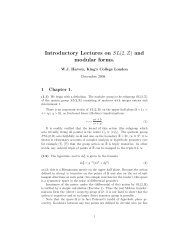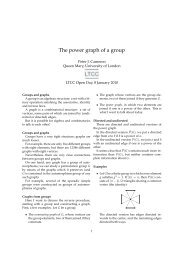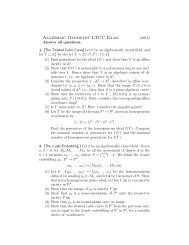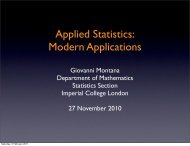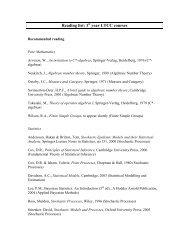Algebraic number theory LTCC 2008 Solutions to Problem Sheet 1
Algebraic number theory LTCC 2008 Solutions to Problem Sheet 1
Algebraic number theory LTCC 2008 Solutions to Problem Sheet 1
Create successful ePaper yourself
Turn your PDF publications into a flip-book with our unique Google optimized e-Paper software.
4 <strong>Algebraic</strong> <strong>number</strong> <strong>theory</strong>, <strong>Solutions</strong> <strong>to</strong> <strong>Problem</strong> <strong>Sheet</strong> 1, <strong>LTCC</strong> <strong>2008</strong><br />
Hence v 1 + · · · + v r+s = (0, . . . , 0). Therefore for every i = 1, . . . , r + s − 1<br />
we have<br />
⎛<br />
v 1<br />
⎞ ⎛<br />
⎞<br />
.<br />
.<br />
⎟<br />
⎜<br />
⎟<br />
det<br />
⎜<br />
⎝<br />
v i−1<br />
v i+1<br />
.<br />
v r+s−1<br />
v r+s<br />
= det<br />
⎟ ⎜<br />
⎠ ⎝<br />
⎛<br />
= det<br />
⎜<br />
⎝<br />
⎜<br />
= ± det ⎝<br />
v 1<br />
.<br />
.<br />
v i−1<br />
v i+1<br />
.<br />
v r+s−1<br />
−v 1 − · · · − v r+s−1<br />
⎞<br />
v 1<br />
.<br />
v i−1<br />
v i+1<br />
.<br />
v r+s−1<br />
−v i<br />
⎛<br />
⎟<br />
⎠<br />
v 1<br />
.<br />
v r+s−1<br />
⎞<br />
⎟<br />
⎠ .<br />
This shows that the absolute value of this determinant is independent of<br />
i. Hence the definition of the regula<strong>to</strong>r does not depend on the choice of<br />
(r + s − 1) × (r + s − 1)-minor.<br />
Choice of order of the embeddings:<br />
Changing the order of the embeddings only permutes the rows of the matrix,<br />
therefore the absolute value of the determinant of an (r +s−1)×(r +s−1)-<br />
submatrix does not change.<br />
Choice (and order) of fundamental units:<br />
Suppose that β 1 , . . . , β r+s−1 is another system of fundamental units for R × K .<br />
Then λ(α 1 ), . . . , λ(α r+s−1 ) and λ(β 1 ), . . . , λ(β r+s−1 ) are both Z-bases of the<br />
free abelian group λ(R × K ). Therefore we have λ(β j) = ∑ r+s−1<br />
i=1<br />
λ(α i )c ij with<br />
c ij ∈ Z. If C denotes the matrix (c ij ) 1≤i,j≤r+s−1 then<br />
Similarly<br />
⎟<br />
⎠<br />
(λ(β 1 ), . . . , λ(β r+s−1 )) = (λ(α 1 ), . . . , λ(α r+s−1 )) · C.<br />
(λ(α 1 ), . . . , λ(α r+s−1 )) = (λ(β 1 ), . . . , λ(β r+s−1 )) · D<br />
for an (r + s − 1) × (r + s − 1)-matrix D with entries in Z. It follows that<br />
CD is equal <strong>to</strong> the (r + s − 1) × (r + s − 1) unit matrix. In particular<br />
det(C) det(D) = 1, so det(C) = ±1 since these determinants are integers.<br />
Now the equation<br />
(λ(β 1 ), . . . , λ(β r+s−1 )) = (λ(α 1 ), . . . , λ(α r+s−1 )) · C.<br />
shows that an (r + s − 1) × (r + s − 1)-minor of the matrix with columns<br />
λ(β 1 ), . . . , λ(β r+s−1 ) is equal <strong>to</strong> det(C) times an (r+s−1)×(r+s−1)-minor<br />
of the matrix with columns λ(α 1 ), . . . λ(α r+s−1 ). Hence the absolute values<br />
of these minors are equal. This shows that the definition of the regula<strong>to</strong>r<br />
does not depend on the choice of system of fundamental units.



